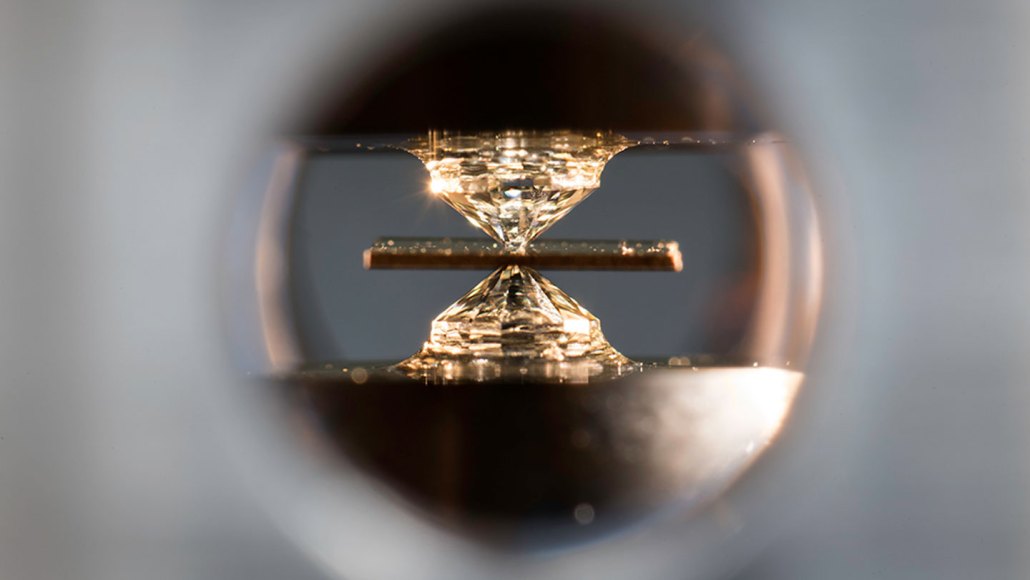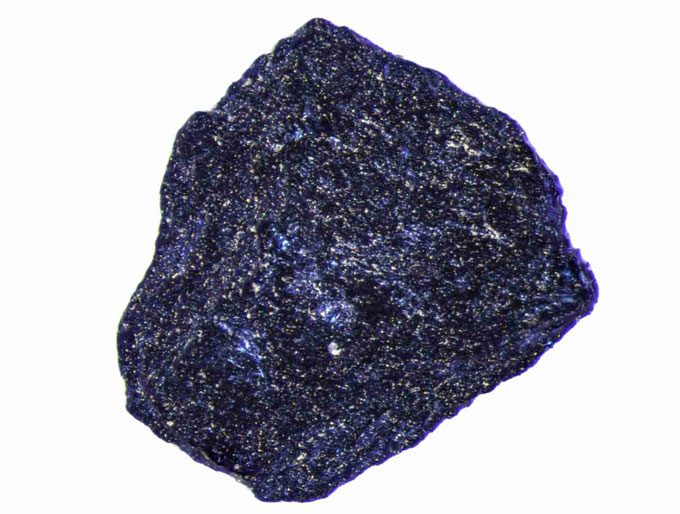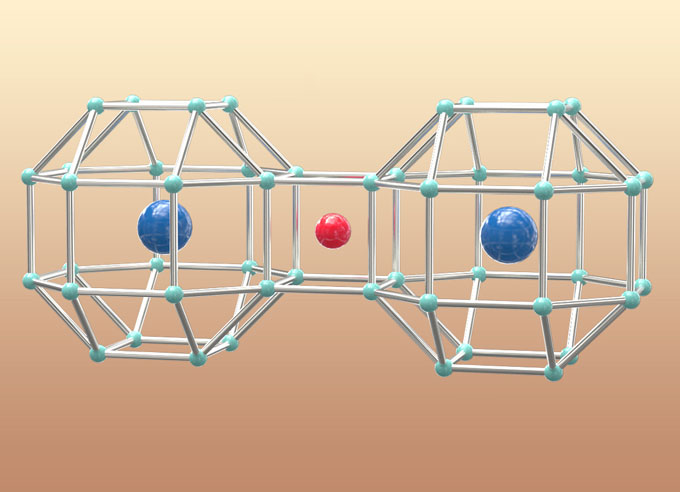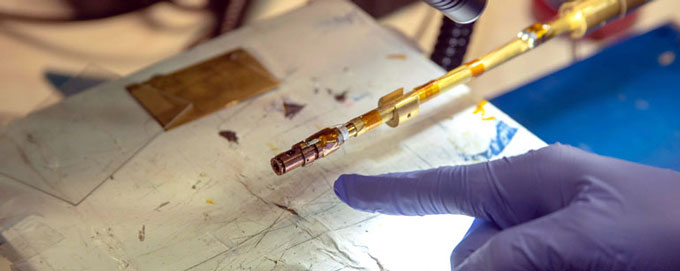
Physicists use diamond anvils (one shown) to crush materials at high pressure in hopes of creating new superconductors.
J. Adam Fenster/University of Rochester
- More than 2 years ago
With his bold claims of revolutionary room-temperature superconductors, physicist Ranga Dias of the University of Rochester in New York propelled the field of high-pressure physics into the spotlight.
Now, after two paper retractions and plagiarism allegations, there’s a haze of suspicion around Dias, and some physicists are worried that outsiders might suspect that the entire field is in disarray. “The big risk is that this whole thing … sheds a negative light on this field,” says theoretical physicist Lilia Boeri.
But other research on high-temperature superconductors is solid, many researchers say. Multiple groups have replicated key results, and theoretical calculations agree with real-world experiments. Physicists are investigating new classes of superconductors and confirming theoretical predictions. The hope is that such gradual advances will eventually lead scientists to a more practical superconductor.
“The sad thing is that there is a lot of nice work going on in the field but this [controversy] has taken so much attention,” says Boeri, of the Sapienza University of Rome.
To further shore up the scientific legitimacy of their claims, scientists are now developing new ways to identify superconductivity, debating what standards should be met before one can claim to have achieved superconductivity, and discussing new norms around sharing data.
The work, scientists say, could help researchers stave off any future questionable claims of superconductivity, which aren’t uncommon in physics. “We all recognize that our field is in danger of being written off by the wider scientific community because of all of the false positives,” says theoretical physicist Peter Hirschfeld of the University of Florida in Gainesville.
Controversy surrounding Dias’ superconductivity claims keeps growing
With the power to conduct electricity without resistance, superconductors promise to transform modern technology — if they can be made to function at temperatures and pressures fit for everyday use. This tantalizing possibility fuels hype to levels uncommon in the typically esoteric realm of physics research.
The first eye-popping superconductivity claim from Dias’ group came in 2020. While most superconductors must be cooled to very cold temperatures to function, a material of carbon, sulfur and hydrogen remained superconducting up to 15° Celsius (59° Fahrenheit), he and colleagues reported in Nature (SN: 10/14/20).
That material, like many of the highest-temperature superconductors, had to be squeezed to high pressure, meaning it was not feasible for practical use. Still, it was purportedly the first demonstration of a long-sought room-temperature superconductor.
But after other scientists raised doubts about the data and methods, Nature retracted the paper, against the protestations of Dias and the other authors (SN: 10/3/22).
In March, Dias’ team countered with an even bigger claim (SN: 3/7/23). A material made of lutetium, nitrogen and hydrogen superconducts at room temperature and under pressures much closer to atmospheric pressure, they reported in Nature.

Meanwhile, skeptics delved into Dias’ history, alleging widespread plagiarism in his Ph.D. thesis, according to an analysis reported in a news article in Science. The digging also flagged a 2021 paper that Dias coauthored in Physical Review Letters, or PRL, unrelated to the two Nature papers on superconductivity. An investigation by PRL found evidence of data fabrication, Nature reported in July. With the agreement of all the authors but Dias, PRL retracted the paper on August 15.
Asked about the retraction, Dias asserted in an email that “there has been no data fabrication, data manipulation or any other scientific misconduct in connection with our work.”
Dias is now under investigation by the University of Rochester, a university spokesperson said.
Amid all this controversy, outsiders might imagine that the entire field is fishy, says physicist Mikhail Eremets of the Max Planck Institute for Chemistry in Mainz, Germany. “But in fact, it’s completely not so, because other people … are doing really good, great and very well-confirmed [work].”
Reproducibility is key for high-temperature superconductors
High-pressure physics is highly specialized, and experiments that succeed in one laboratory can be challenging to replicate elsewhere. But consensus has gradually formed around several record-breaking superconductors.
The research centers around hydrogen-rich materials known as hydrides. This choice was inspired by a prediction that pure hydrogen would become a superconducting metal when squeezed to extreme pressure (SN: 8/10/16). Since those pressures proved difficult to reach, scientists added other elements to hydrogen in hopes of lowering the pressure needed.
The first major success was a compound of sulfur and hydrogen, which broke the record at the time for the highest-temperature superconductor (SN: 12/15/15). It superconducts up to around 203 kelvins (−70° C), Eremets and colleagues reported in Nature in 2015. Then, in 2018, scientists crowned the current record holder (discounting Dias’ work), a compound of lanthanum and hydrogen, which superconducts up to about −20° C (SN: 9/10/18).
In both cases, multiple groups have confirmed the results. And theoretical calculations agree that the materials are superconducting at these high temperatures. Even so, both superconductors require a squeeze more than a million times the pressure of Earth’s atmosphere, limiting their practical usefulness. Other high-temperature superconductors, such as yttrium hydride, have also been replicated by multiple groups.
In contrast, physicists have struggled to conclusively reproduce the Dias group’s lutetium superconductor, or to come up with a convincing theoretical explanation for it. Coupled with the previous retractions, that leaves many researchers doubtful. “I absolutely do not trust any results of this group,” says physicist Dmitrii Semenok of the Center for High Pressure Science & Technology Advanced Research in Beijing.
In an email, Dias waved away concerns, writing that “if people are struggling to replicate my work, that’s not surprising — not everyone will be able to do what took me years to accomplish.”
New superconducting materials make their debut
In the light of the retractions and failed replications, many physicists think other developments in the field are more worthy of their attention.
One hot topic is ternary hydrides, materials in which hydrogen is combined with two additional elements instead of just one. By exploring the many possible combinations of elements in the periodic table, physicists hope to find new superconductors that work at lower pressures and higher temperatures than the hydrides studied so far (SN: 3/19/21).
In June, scientists reported the first example of a ternary hydride with a brand-new structure of atoms, never seen in previous binary hydrides. Made of lanthanum, beryllium and hydrogen, the material was superconducting up to about 100 kelvins (about −173° C), researchers report in a paper published in PRL. That’s not a record by any means. But the material requires less pressure than some other hydrides, says physicist Yanming Ma of Jilin University in Changchun, China. “We have the first example. Then later on, maybe people [will] build on our work.”
In another recent development, physicists tied up a decade-old loose end. A superconductor predicted in 2012, calcium hydride, was finally produced, two independent teams reported in 2022 in PRL and in Nature Communications. This was the first hydride superconductor predicted with a “clathrate” structure, in which the hydrogen atoms form a cage around another type of atom.
This clathrate structure has since been found in other high-temperature superconductors, including the accepted record holder, lanthanum hydride. The discovery of calcium hydride “is a really nice success,” says theoretical physicist Eva Zurek of the University at Buffalo in New York. “Examples like this go counter to saying … that the whole field is doing crappy work.”

So far, hydrides still require a hefty squeeze to superconduct. “It’s very difficult to lower the pressure of these … hydrides to ambient conditions,” says theoretical physicist Hanyu Liu of Jilin University.
Some physicists are going beyond hydrogen. Physicist Timothy Strobel is swapping in other light elements. He’s studying clathrates made not with hydrogen but with boron and carbon — the fifth and sixth elements on the periodic table.
In such materials, “we would expect moderately high-temperature superconductivity, but not as high as hydrogen,” says Strobel, of the Carnegie Institution for Science in Washington, D.C.
But that trade-off may be worth it. With such materials, scientists hope to find structures sturdy enough to persist at atmospheric pressure. It’s similar to carbon’s most flashy form, diamond, which forms under pressure but remains intact once that pressure is released. In a paper published in January in the Journal of the American Chemical Society, Zurek, Strobel and colleagues predict that some flavors of these materials could be superconductors at temperatures up to 88 kelvins (about –185° Celsius ) under atmospheric pressure.
That might seem low in comparison to the high-pressure hydrides. But temperatures above 77 kelvins (about −196° C), the boiling point of liquid nitrogen, are more easily achievable in practical use, because costly liquid helium isn’t required for coolant. In contrast, high pressures are currently prohibitive for practical purposes. Reaching ambient pressure may be more important than room temperature, Strobel argues.
Physicists want to raise the bar for claiming superconductivity
In parallel to investigating new superconductors, high-pressure physicists are also discussing how to avoid controversies in their field in the future.
Some are calling for more sharing of raw data, with the intent of making claims easier to check and experiments easier to replicate. Semenok, for example, posts raw data online for most of his papers. Other physicists in the field find the idea appealing. “This really should be standard for major journals,” Eremets says. “In our age, why not?”
While Dias’ group provided data associated with their lutetium superconductor paper in Nature, that hasn’t satisfied other scientists. “In my mind, basically none of the data that’s been uploaded is raw data,” says physicist James Hamlin of the University of Florida in Gainesville. “Raw data is a data file that was created by your measurement software on the day of the measurement and then not touched after that point.” The Dias team’s data doesn’t fit that bill, Hamlin says.
Physicists are also working to strengthen the evidence for superconductivity in their materials. It’s not all about resistance, or lack thereof. Superconductors exhibit other hallmarks. One telltale sign is the Meissner effect, in which a material expels magnetic fields. This and other effects can help confirm that the superconductivity is real.
But high-pressure experiments involve mere specks of material squeezed between two diamonds. Making clear measurements of the Meissner effect and other hallmarks of superconductivity can be difficult under such conditions.
So scientists are coming up with additional ways to confirm superconductivity. For example, when certain types of superconductors are exposed to a magnetic field and the magnetic field is later switched off, a residual magnetic field remains trapped within the superconductor. In a June paper in Nature Physics, Eremets and colleagues reported measurements of trapped magnetic fields in both the sulfur and lanthanum hydrides, further solidifying the case for their superconductivity.

Some physicists are also calling for a set of criteria that scientists would be expected to meet before claiming to have found a new superconductor. “There should be some general standard of what one should prove to claim superconductivity,” Boeri says.
Besides measuring a dramatic drop in resistivity, Hirschfeld suggests requiring other markers of superconductivity, such as showing that a magnetic field lowers the temperature below which a material becomes a superconductor. Several other measurements would be required for the scientific community to accept the result, with the results confirmed by independent groups.
Despite efforts to bolster superconductor research, spurious claims of room-temperature superconductivity will probably be challenging to eliminate. “It’s not something rare; it happens from time to time,” Semenok says. The allure of the room-temperature superconductor looms large.
Case in point — a purported room-temperature, ambient-pressure superconductor called LK-99, reported prior to peer review at arXiv.org in July, went viral on social media. Further scientific investigation soon mostly debunked the claim.
As for Dias, his lutetium-based superconductor still stands in the scientific record — for now. After researchers raised concerns about the paper, Nature began looking into it. “We are currently assessing concerns that have been raised with us, but we cannot discuss the specifics of those concerns relating to any particular paper while such post-publication assessments are underway,” a spokesperson for Nature said.
The paper now bears a cautionary editor’s note. The reliability of the paper’s data, it says, is in question.







